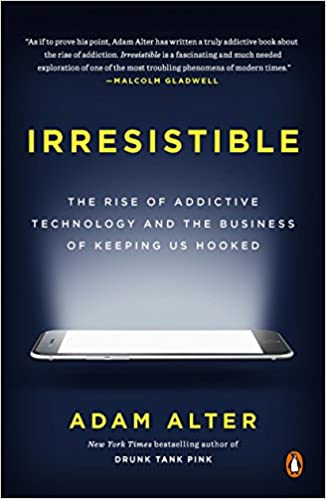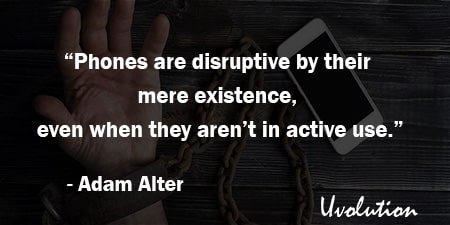Irresistible by Adam Alter Book Summary
The Book in 1 Sentences
Irresistible: The Rise of Addictive Technology and the Business of Keeping Us Hooked
“Irresistible traces the rise of addictive behaviors, examining where they begin, who designs them, the psychological tricks that make them so compelling, and how to minimize dangerous behavioral addiction as well as harnessing the same science for beneficial ends.
If app designers can coax people to spend more time and money on a smartphone game, perhaps policy experts can also encourage people to save more for retirement or donate to more charities. ...
The age of behavioral addiction is still young, but early signs point to a crisis.
Addictions are damaging because they crowd out other essential pursuits, from work and play to basic hygiene and social interaction. The good news is that our relationships with behavioral addictions aren’t fixed.
There’s much we can do to restore the balance that existed before the age of smartphones, emails, wearable tech, social networking, and on-demand viewing. The key is to understand why behavioral addictions are so rampant, how they capitalize on human psychology, and how to defeat the addictions that hurt us, and harness the ones that help us.” ~ Adam Alter
7 BIG Ideas
Irresistible Book by Adam Alter Summary
1. Never get high on your own supply!
“At an Apple event in January 2010, Steve Jobs unveiled the iPad
What this device does is extraordinary . . . It offer the best way to browse the web; way better
than a laptop and way better than a smartphone . . . It’s an incredible experience . . . It’s
phenomenal for mail; it’s a dream to type on.
For ninety minutes, Jobs explained why the iPad was the best way to look at photos, listen to
music, take classes on iTunes U, browse Facebook, play games, and navigate thousands of apps.
He believed everyone should own an iPad.
But he refused to let his kids use the device.”
“It seemed as if the people producing tech products were following the cardinal rule of drug dealing: never get high on your own supply. This is unsettling.
Why are the world’s greatest public technocrats also its greatest private technophobes? Can you imagine the outcry if religious leaders refused to let their children practice religion?”
“Children are especially vulnerable to addiction, because they lack the self-control that prevents many adults from developing addictive habits.
Regulated societies respond by refusing to sell alcohol and cigarettes to children—but very few societies regulate behavioral addictions. Kids can still play with interactive tech for
hours at a time, and they can still play video games as long as their parents will allow.”
2. The addict in all of us!
“... there’s so much more to it than an addictive personality. Addicts aren’t simply weaker
specimens than non-addicts; they aren’t morally corrupt where non-addicts are virtuous.
Instead, many, if not most of them are unlucky. Location isn’t the only factor that influences
your chances of becoming an addict, but it plays a much bigger role than scientists once thought.
Genetics and biology matter as well, but we’ve recognized their role for decades. What’s new,
and what only became clear in the 1960s and 1970s, is that addiction is a matter of environment, too.
Even the sturdiest of our ranks—the young G.I.s who were free of addiction when they left
Vietnam—are prone to weakness when they find themselves in the wrong setting. And even
the most determined addicts-in-recovery will relapse when they revisit people and places that
remind them of the drug.”
“According to Tristan Harris, a ‘design ethicist,’ the problem isn’t that people lack willpower, it’s that ‘there are a thousand people on the other side of the screen whose job it is to break down the self-regulation you have.’”
3. Don't waste 11 years!
“Most people spend between one and four hours on their phones each day—and many far longer.
This isn’t a minority issue. If, as guidelines suggest, we should spend less than an hour on our
phones each day, 88 percent of Holesh’s users were overusing. They were spending an average of a quarter of their waking lives on their phones—more time than any other daily activity, except sleeping.
Each month almost one hundred hours was lost to checking email, texting, playing games, surfing the web, reading articles, checking bank balances, and so on. Over the average
lifetime, that amounts to a staggering eleven years.
On average they were also picking up their phones about three times an hour. This sort of overuse is so prevalent that researchers have coined the term ‘nomophobia’ to describe the fear of being without mobile phone contact.”
“Phones are disruptive by their mere existence, even when they aren’t in active use.
They’re distracting because they remind us of the world beyond the immediate conversation, and the only solution, the researchers wrote, is to remove them completely.”
4. Addiction = Slavery
“Addiction originally meant a different kind of strong connection: in ancient Rome, being
addicted meant you had just been sentenced to slavery. If you owed someone money and
couldn’t repay the debt, a judge would sentence you to addiction.
You’d be forced to work as a slave until you’d repaid your debt. This was the first use of the word addiction, but it evolved to describe any bond that was difficult to break.”
“Sixty-one percent of these people [in a Netflix study] reported some degree of binge-watching, which most respondents defined as ‘watching between two and six episodes of a TV show in one sitting.’”
5. Slow down!
“How long do you think the average office email goes unread? I guessed ten minutes. The truth is just six seconds. In reality, 70 percent of office emails are read within six seconds of arriving.
Six seconds is less time than it’s taken you to read this paragraph so far, but it’s long enough for the average worker to disrupt whatever he’s doing to open his email program and click on the incoming email.
This is hugely disruptive: by one estimate, it takes up to twenty-five minutes to become re-immersed in an interrupted task. If you open up just twenty-five emails a day, evenly
spaced across the day, you’ll spend literally no time in the zone of maximum productivity.”
6. Aftereffects of addiction
“Cash invited me to participate in a group discussion with the centers’ inpatients. As the session began, she repeated a mantra that I’d heard a couple of times already: ‘Remember: once your cucumber brain has become pickled, it can never go back to being a cucumber.’
The phrase was designed to discourage inpatients from doing what Vaisberg had done when he left the center:
believing that they could play just one more game without their addictions returning. Cash
was trying to explain that the inpatients’ brains were forever pickled, in a sense, and that their
addictions were always on the cusp of being rekindled.
The mantra was a cute way of saying something very confronting: that it’s impossible to ever completely escape the aftereffects of addiction.”
“Isaac told me that the most dangerous time for an addict is the first moment when things are going so well that you believe you’ve left the addiction behind forever.”
7. Self-Determination Theory
“The technique’s effectiveness is explained by one of the dominant theories in motivation
research: Self-Determination Theory (SDT).
SDT explains that people are naturally proactive, especially when a behavior activates one of three central human needs: the need to feel in command of one’s life (autonomy); the need to form solid social bonds with family and friends (relatedness); and the need to feel effective when dealing with the external environment (competence).
Though addictive behaviors are designed to soothe psychological discomfort, they also tend to frustrate one or more of these needs. A motivational interview makes that frustration clear:
if you’re asked how your Instagram use affects your well-being, you’re going to see that it’s compromising your productivity, your relationships, or both.
Far from rendering a person powerless in the face of her addiction, she’s left to feel both motivated and capable of changing for the better.”
“I’m not here to preach to you or tell you what you ‘should’ do; how would I know, it’s your life and not mine. I believe people know what’s best for them.
I don’t have an agenda, just a goal: to see if there is anything about the way you take care of
your health that you would like to change, and if so, to see if I can help you get there.
How does that sound to you?”
That was my QUICK summary of the great book Irresistible by Adam Alter. If you’re interested, get your copy. There is a HUGE amount of life-changing ideas in this book, and we’ve only touched on a tiny bit of it.
Buy The Book: Irresistible by Adam Alter

GET Blinkist 7 Days FREE Trial
3000+ Book Summaries
(Audio and Text)








